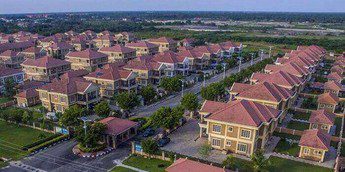The Lagos real estate market, a cornerstone of Nigeria’s economic landscape, continues to demonstrate remarkable resilience despite macroeconomic challenges such as inflation, currency fluctuations, and rising construction costs. According to the 2024 Lagos Real Estate Market Overview report by Estate Intel, hyper-local retail and suburban housing have emerged as key drivers of growth, adapting to shifting consumer behaviors and economic realities. These sectors have not only weathered the storm but are also reshaping the city’s property landscape by catering to the evolving needs of residents and businesses. This article delves into the dynamics of these trends, exploring how hyper-local retail and suburban housing are sustaining Lagos’ real estate market, while also examining the broader implications for investors, developers, and policymakers.
The Resilience of Lagos’ Real Estate Market
Lagos, Nigeria’s commercial capital, is a bustling metropolis with a population exceeding 20 million and a real estate market that reflects its vibrant, complex economy. The city’s property sector has long been a barometer of Nigeria’s economic health, navigating challenges such as foreign exchange volatility, high inflation rates (which hit 33.4% in July 2024, according to the National Bureau of Statistics), and increasing costs of construction materials. Despite these hurdles, the real estate market has shown adaptability, with certain segments thriving by aligning with changing consumer preferences and economic conditions.
The Estate Intel report highlights that hyper-local retail and suburban housing are at the forefront of this resilience. These sectors have capitalized on the growing demand for convenience, affordability, and accessibility, driven by Lagos’ rapidly expanding population and urban sprawl. As the city continues to grow, developers and investors are recalibrating their strategies to focus on these high-demand areas, ensuring the market remains dynamic and forward-looking.
Hyper-Local Retail: Meeting Consumers Where They Are
The Rise of Hyper-Local Retail
Hyper-local retail, characterized by small-scale retail centers strategically located within or near residential neighborhoods, has become a cornerstone of Lagos’ real estate market. Unlike large, centralized shopping malls, hyper-local retail focuses on convenience, offering everyday essentials such as groceries, pharmaceuticals, and quick-service dining options. These centers cater to the immediate needs of residents, reducing the necessity for long commutes in Lagos’ notoriously traffic-congested streets.
The Estate Intel report notes a significant uptick in the development of hyper-local retail centers across Lagos in 2024. This trend is driven by several factors, including rising fuel costs, which have made long-distance travel less appealing, and a growing preference for quick, accessible shopping experiences. For instance, retail centers like the Circle Mall in Lekki and smaller neighborhood markets in areas like Ikeja and Surulere have gained traction by offering tailored services to local communities.
Why Hyper-Local Retail Thrives
The success of hyper-local retail can be attributed to its alignment with Lagosians’ lifestyles. With the city’s population increasingly concentrated in suburban and peri-urban areas, residents are seeking retail options that are within walking distance or a short drive from their homes. These centers typically feature supermarkets, pharmacies, and fast-food outlets, which cater to daily needs and provide a cost-effective alternative to larger malls, which often require significant travel time and expense.
Moreover, hyper-local retail centers are more resilient to economic fluctuations. Unlike high-end malls, which rely heavily on discretionary spending, these neighborhood hubs focus on essential goods and services, ensuring steady foot traffic even during economic downturns. The report cites examples of retail chains like Shoprite and Spar, which have expanded their presence in suburban areas, as well as smaller, independent retailers that have carved out niches in densely populated neighborhoods.
Developer Strategies and Investment Opportunities
Developers are increasingly prioritizing hyper-local retail projects due to their lower capital requirements and faster return on investment compared to large-scale developments. These projects require less land and infrastructure, making them viable in a market where land prices in prime areas like Victoria Island and Ikoyi remain prohibitively high. For instance, a hyper-local retail center in a suburban area like Ikorodu or Badagry can be developed at a fraction of the cost of a mall in Lekki, yet still generate consistent revenue.
Investors are also drawn to the sector’s stability. The Estate Intel report indicates that hyper-local retail centers have maintained occupancy rates above 80% in 2024, even as larger commercial properties faced higher vacancy rates due to economic pressures. This resilience has made hyper-local retail a preferred asset class for real estate investment trusts (REITs) and private equity firms looking to diversify their portfolios.
Challenges and Future Outlook
Despite its growth, hyper-local retail faces challenges, including competition from informal markets and e-commerce platforms. Street markets and roadside vendors remain popular in Lagos due to their affordability and accessibility, while online retailers like Jumia and Konga are capturing a growing share of the market. To stay competitive, developers of hyper-local retail centers must focus on creating value-added experiences, such as clean, safe environments and reliable power supply, which are often lacking in informal markets.
Looking ahead, the hyper-local retail sector is poised for further expansion as Lagos’ population continues to grow and urbanize. Developers are exploring innovative formats, such as mixed-use developments that combine retail with residential or office spaces, to maximize land use and appeal to diverse consumer needs. The integration of technology, such as cashless payment systems and loyalty programs, is also expected to enhance the appeal of these centers.
Suburban Housing: A Response to Urban Sprawl and Affordability
The Shift to Suburban Living
Parallel to the rise of hyper-local retail, suburban housing has emerged as a critical driver of Lagos’ real estate market. As the city’s population grows and land prices in central areas like Lagos Island and Ikoyi soar, many residents are moving to suburban areas such as Ikorodu, Epe, Badagry, and Ogun State’s border communities. These areas offer more affordable housing options, larger land sizes, and a reprieve from the congestion of central Lagos.
The Estate Intel report highlights that suburban housing developments have seen a surge in demand in 2024, driven by middle-class families and young professionals seeking affordable homeownership opportunities. These developments range from low-cost housing estates to mid-range gated communities, catering to a broad spectrum of income groups. For example, projects like the Lekki Gardens estates and developments along the Lagos-Ibadan Expressway have attracted significant interest due to their affordability and proximity to emerging commercial hubs.
Factors Driving Suburban Housing Demand
Several factors are fueling the demand for suburban housing. First, the rising cost of living in Lagos’ urban core has pushed many residents to seek more affordable alternatives. Land prices in areas like Ikoyi can exceed N500 million per plot, while suburban areas offer plots for as low as N5 million, making homeownership more attainable for the middle class.
Second, improvements in infrastructure, such as the ongoing expansion of the Lagos-Badagry Expressway and the proposed Lagos-Calabar Coastal Highway, have enhanced connectivity between suburban areas and the city center. These developments have made it easier for residents to commute to work or access urban amenities, further boosting the appeal of suburban living.
Third, the rise of remote work, accelerated by the COVID-19 pandemic, has reduced the need for proximity to central business districts. Many professionals now prefer larger, more affordable homes in suburban areas, where they can enjoy better quality of life and access to green spaces.
Developer Innovations and Market Trends
Developers are responding to the suburban housing boom by launching large-scale residential projects tailored to middle-income buyers. These projects often include amenities such as schools, healthcare facilities, and recreational centers, creating self-contained communities that reduce the need for residents to travel to urban areas. For instance, the Alaro City development in the Lekki Free Zone integrates residential, commercial, and industrial components, offering a holistic living experience.
To address affordability concerns, developers are also adopting flexible payment plans and partnering with financial institutions to offer mortgages with lower interest rates. The Estate Intel report notes that some developers have introduced rent-to-own schemes, allowing tenants to gradually acquire equity in their homes, a model that has gained popularity among young professionals.
Challenges in Suburban Housing
Despite its growth, the suburban housing market faces significant challenges. Inadequate infrastructure, such as poor road networks and unreliable electricity, remains a barrier in many suburban areas. Additionally, the rising cost of construction materials, driven by inflation and import dependency, has increased the cost of delivering affordable housing. Developers must navigate these challenges while maintaining competitive pricing to meet demand.
Another issue is the risk of oversupply in certain suburban markets. As developers rush to capitalize on demand, some areas may see an influx of housing projects that outpace actual demand, potentially leading to vacancies and price stagnation. Careful market analysis and strategic planning are essential to avoid such pitfalls.
Future Prospects for Suburban Housing
The outlook for suburban housing remains positive, with continued population growth and government investment in infrastructure expected to drive demand. The Lagos State Government’s focus on affordable housing initiatives, such as the Lagos Home Ownership Mortgage Scheme (LagosHOMS), is also supporting the sector by providing financing options for low- and middle-income earners.
Moreover, the trend toward sustainable development is gaining traction in suburban housing projects. Developers are incorporating eco-friendly features such as solar power, rainwater harvesting, and energy-efficient designs to appeal to environmentally conscious buyers and reduce long-term costs. These innovations are likely to shape the future of suburban housing in Lagos, aligning with global trends toward sustainability and resilience.
Broader Implications for Lagos’ Real Estate Market
The rise of hyper-local retail and suburban housing reflects broader shifts in Lagos’ real estate market, driven by demographic, economic, and technological changes. These trends have significant implications for stakeholders across the value chain, from developers and investors to policymakers and residents.
For Developers and Investors
Developers and investors must continue to adapt to changing consumer preferences by focusing on projects that prioritize convenience, affordability, and sustainability. Hyper-local retail and suburban housing offer attractive opportunities due to their resilience and alignment with market demand. However, success will depend on careful site selection, innovative financing models, and the integration of technology to enhance user experiences.
For Policymakers
The Lagos State Government and other regulatory bodies have a critical role to play in supporting these trends. Investments in infrastructure, such as roads, public transportation, and utilities, are essential to sustain the growth of suburban areas and hyper-local retail centers. Additionally, policies that promote affordable housing, such as tax incentives for developers and subsidies for low-income buyers, can help address the housing deficit, estimated at 3 million units in Lagos alone.
For Residents
For Lagos residents, the rise of hyper-local retail and suburban housing offers greater access to essential services and affordable living options. These developments are improving quality of life by reducing travel times, lowering costs, and creating vibrant, self-sufficient communities. However, residents must also advocate for better infrastructure and services to fully realize the benefits of these trends.
Conclusion
The Lagos real estate market is undergoing a transformative phase, with hyper-local retail and suburban housing leading the charge in fostering resilience and growth. These sectors are not only responding to immediate economic challenges but also laying the foundation for a more sustainable and inclusive urban future. By capitalizing on the demand for convenience and affordability, developers and investors are unlocking new opportunities in a city that continues to defy expectations. As Lagos evolves, the interplay between hyper-local retail, suburban housing, and strategic policymaking will shape the trajectory of its real estate market, ensuring it remains a vital engine of economic growth and opportunity.






